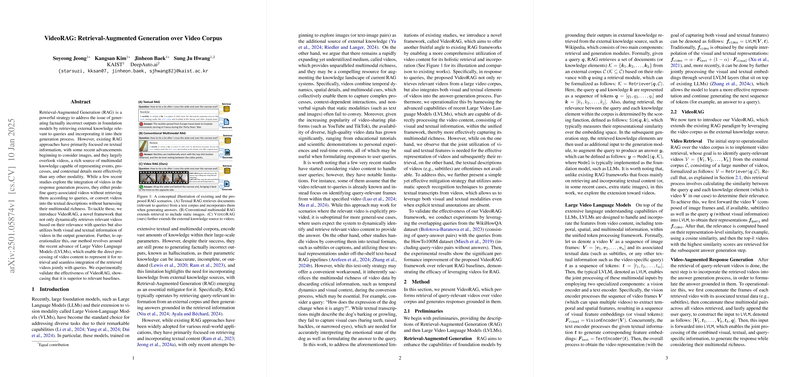Overview of VideoRAG: Retrieval-Augmented Generation over Video Corpus
The paper, "VideoRAG: Retrieval-Augmented Generation over Video Corpus," addresses the limitations of existing Retrieval-Augmented Generation (RAG) systems that predominantly focus on text-based or static image retrieval, by proposing a novel framework capable of leveraging video content as a rich source of external knowledge. This approach opens up new dimensions for RAG systems by utilizing the multimodal richness inherent in video data, which includes temporal dynamics and spatial details that are typically not captured in textual descriptions alone.
Core Contributions
The main contributions of the paper can be summarized as follows:
- Introduction of VideoRAG Framework: The authors propose VideoRAG, a framework designed to dynamically retrieve videos relevant to a query and use both their visual and textual information for answer generation. This is facilitated by adopting Large Video LLMs (LVLMs) that can process video content directly, offering an advantage over systems limited to textual or static image data.
- Dynamic Video Retrieval: Unlike previous works that require pre-selected videos or convert video content into text, VideoRAG integrates a dynamic retrieval system to obtain relevant videos based on query similarity. The approach combines visual and textual feature embeddings for accurate retrieval, optimizing the balance between these modalities.
- Integration with Large Video LLMs: VideoRAG leverages LVLMs to handle and incorporate features from video content effectively. LVLMs are used not only for retrieving videos but also for generating responses that are informed by the retrieved multimodal content.
- Auxiliary Text Generation: The framework addresses the lack of textual data (such as subtitles) in some videos by employing automatic speech recognition to transcribe audio content, thus ensuring that even video data without pre-existing textual layers can be utilized effectively.
Experimental Validation
The research leverages datasets such as WikiHowQA and HowTo100M to validate the efficacy of VideoRAG. The experiments demonstrate that video content significantly enhances answer quality compared to text-only baselines. VideoRAG variants that utilize both textual and visual modalities outperform those using only one type of feature, indicating the complementary nature of multimodal data in enhancing retrieval performance.
Implications and Future Directions
The implications of VideoRAG are significant both practically and theoretically:
- Enhanced Applicability: By using video corpora, VideoRAG can provide more nuanced and detailed responses, potentially improving systems in domains where visual context and temporal understanding are critical, such as educational tools and multimedia content analysis.
- Impact on Multimodal AI: The framework broadens the potential of retrieval-augmented systems, paving the way for advancements in Multimodal LLMs and applications that require comprehensive knowledge integration from diverse data sources.
- Future Research: The paper suggests potential avenues for future research, such as improving the retrieval accuracy of relevant video content, exploring the integration of even finer-grained temporal and spatial sequences in LVLMs, and adapting the approach to other types of content (e.g., 3D videos or AR/VR environments).
In conclusion, the work not only proposes a novel and effective framework for integrating video data into RAG systems but also sets the stage for future explorations into more complex and holistic AI systems capable of handling diverse forms of knowledge sources. This marks a step forward in moving beyond text-centric paradigms, towards fully leveraging the rich mosaic of available information.
